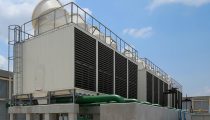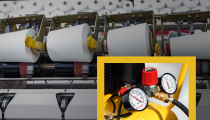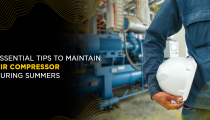Building long-term relationships with clients has become important for every…

What Are Air Receivers? Why Are They Important?
The importance of having a smoothly functioning air receiver in any compressed air system is immense. Without the receiver, there is every chance of the loading & unloading cycles of the compressor becoming larger, and more pressure being put on the air compressor. Alternatively known as receiver tanks or vessels, these air receivers have to be of the correct size – and need to be set up properly – to effectively serve as a buffer between the changing pressure (due to demand fluctuations) and the compressor system. In what follows, we will discuss about air receivers in detail:
What Exactly Is An Air Receiver?
Simply put, an air receiver is a tank-like system that serves the purpose of receiving and storing compressed air (after the air compressor generates it). As such, the receiver tank maintains a reserve supply of compressed air that can be used later – even when the compressor is not turned on. This is particularly useful during peak demand levels.
By ensuring secure temporary storage of compressed air, the air receiver tank bolsters the overall efficiency of the underlying compressor system. Thanks to the functionality of the air receivers, the air compressor itself is protected from abrupt demand spikes. As a result, the service life of the system is enhanced too. Working as a ‘pressure vessel’, an air receiver tank can also serve as a secondary heat exchanger (for the air dryers).
Size Of Air Receivers
Air compressor systems can be of different types and varieties. Hence, air receivers of the same size cannot be used in all compressed air setups. That’s precisely why the top air compressor manufacturers in India offer quality-assured air receiver vessels with different horizontal and vertical configurations. This ensures that buyers can select the receiver that would be the most suitable for their requirements.
Selecting air receiver tank(s) of the correct size is of paramount importance. When the ‘right’ receiver is used in the compressor installation, peak compressed air demands (which are typically short-term demands) can be met effectively, total energy consumption can be brought down, fluctuations in pressure levels can be minimised, and the overall safety factor is enhanced.
Maximum Pressure Of Air Receiver Tanks
The pressure in an air receiver tank plays a key role in determining its usability. Both fixed and variable-speed drive (VSD) air compressors generally have the capacity to generate compressed air at more than 170 psig. The maximum pressure of the air receiver should ideally be in sync with the precise requirements at the concerned industrial facility. As a rule of thumb, the output pressure of compressed air systems should determine the required pressure in air receiver tanks.
Contrary to what many believe, increasing the air receiver pressure does not result in greater flows and higher air volumes for the industrial processes. In fact, it is important to track when the maximum pressure level in the receiver tank is reached – and the excess pressure has to be released. This is done by the pressure relief valve present in the air receiver.
Air Receivers Boost The Operational Efficiency Of Compressed Air Systems
Air compressors typically work in cycles. During these operation cycles, there can be significant losses/wastage of compressed air output (for instance, at the time of venting in rotary screw air compressors). Since air receivers reduce venting and cycling, such output losses are minimised, and mechanical efficiency is enhanced.
Since the receiver tanks/vessels store compressed air, the operating pressure on the compression system goes down. This, in turn, ensures minimal wear & tear and other mechanical fatigue-related damages. Since the receiver also has the capability to remove excess moisture from the system, air dryer efficiency goes up as well, and energy savings get an additional boost.
The Need For ‘Dry’ and ‘Wet’ Compressed Air Storage
Based on the nature of industrial applications, users can require ‘dry’ or ‘wet’ air storage in the compressed form. The selection of an air receiver tank should be done after keeping this under consideration. While the design and functionality of air receiver tanks for ‘dry’ and ‘wet’ compressed air systems is mostly similar, the key difference lies in the location where the tank is set up.
While both wet and dry compressed air storage systems have their respective advantages, a combination of the two is considered in many industrial applications. The ratio of dry to wet capacity has to be determined carefully (generally two-thirds dry capacity and one-third wet capacity). For applications that do not have peaks in compressed air demands, dry air receiver tanks are generally not required.
Air Receivers Boost The Longevity Of Compressed Air Systems
Air receivers designed by the top compressed air suppliers are customised as per buyer requirements. The tank safeguards the main components of compressed air systems. This keeps the overall maintenance requirements low, and frequent air compressor repairs are not necessitated. The durability of the system is enhanced. In particular, probable problems arising due to spikes in air pressure are done away with.
In reciprocating compressors, air receivers ensure uniformly steady air flows to the system – by dampening the pulsations in the discharge line. In addition, the receiver tanks can also remove unwanted particulate matter, dirt, and other contaminants from the inlet filter. Apart from the primary air receiver tanks, many systems also use secondary containers to minimise fluctuations in air pressure.
Maintenance Of Air Receiver Tanks
Given the importance of air receivers in compressed air systems, users have to be very careful about the maintenance of these storage vessels. For starters, air receivers with proper product & quality certifications should be used – and the pressure gauge of the receiver tank should be properly functioning. The drainage requirements of the tank also need to be ascertained. This would prevent internal accumulations inside the air receiver.
Corrosion is one of the biggest reasons behind the diminished functionality of air receiver tanks over time. Hence, it is important to inspect the receiver vessel regularly – and make sure that there are no cracks, seam stresses, and/or other wall damages. Air receivers should not be over-pressurised either. Professionals handling the air receiver tanks should be given proper training, so that problems do not crop up during operations.Periodic testing and certification as per the local Government authorities should be complied with to ensure safety of the receiver and workplace.
Apart from driving efficiency and generating significant energy savings, high-quality air receiver tanks boost overall process safety levels as well. Leading air compressor suppliers in India have different varieties of air receivers in their portfolio – customised to meet the varying requirements of the underlying applications. As the usage of air compressors continues to grow (covering more & more sectors), the demand for air receivers will escalate as well. While they are not always talked about, it can be safe to say that air receivers are definitely an integral part of compressed air systems.




